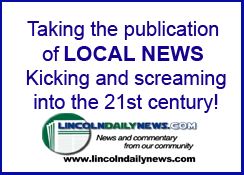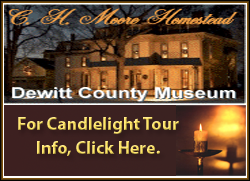 The
heritage area consists of 42 counties in
central Illinois, with Logan and Sangamon
counties being in the center of the region. The
heritage area consists of 42 counties in
central Illinois, with Logan and Sangamon
counties being in the center of the region.
The goal for the region is to develop a
vast number of historical locations and
attractions that will draw visitors into the
area for lengthy stays.
After spending the first half of the
two-hour meeting listening to information
provided by Peter Benton and Elizabeth
Watson of Heritage Strategies, the last
hour, guests in the room were given the
opportunity to voice their ideas and discuss
what they would like to see happen to
promote tourism in the heritage area, for
the purpose of compiling a list of possible
actions for the management plan that is set
to be completed by the end of November 2011.

The first person to speak was Jan
Schumacher of the Logan County Board, who
said a visitor center located immediately
off Interstate 55 in Lincoln would be a
great asset to the community. She commented
that information is available throughout the
area about tourism in Logan County, but to
find it, visitors have to drive into town,
and not everyone will.
It was noted there is an "attractions"
sign off the interstate for Lincoln, but
there are no attractions listed on it.
Geoff Ladd of the Abraham Lincoln Tourism
Bureau said funding through the state and
the Illinois Historic Preservation Agency
for signage has always been an issue. He
said Postville Courthouse and Mount Pulaski
Courthouse both could qualify as
"attractions" on state signage, but there is
no money to get the signs done.
According to Robert Crosby, the Looking
for Lincoln Heritage Coalition project
manager, such signage has been an ongoing
battle with the state everywhere, but being
national gives the area more leverage.
Wanda Lee Rohlfs of Main Street Lincoln
commented on the 49 areas in Logan County
that are directly related to Abraham
Lincoln. She referred to earlier comments
from Watson and Benton about trails and
tours and said she'd like to see these 49
sites linked together in a heritage trail.
Crosby talked about establishing
self-guided tours along a trail. This is
something that Logan County already has to a
certain extent. Main Street has established
the 49 locations and has a cell phone tour
brochure available through their office. The
brochure provides a cell phone number and
codes for each site as well as GPS
coordinates for easy driving to the
location.
Watson said that countryside driving
tours are a wonderful way to attract
tourists but need to be publicized.

"Visitors won't come if they aren't sure
there is something to do or see," she said.
Watson talked about diversity, saying it
is common in most regions that historical
societies, preservation groups and tourism
volunteers are not necessarily made up of
young people.
Succession planning is what will keep the
Lincoln heritage and history alive, and that
means getting young people involved now, so
that they can learn and become as dedicated
to the history of the community as those who
are currently involved.
A comment was made that in order to do
that, those in charge now need to learn how
to talk to young people the way they listen.
Watson drew on the comment about talking
to young people the way they listen and said
the region needed to explore social media
and other means of communication.
Sue Pridemore of the Midwest Regional
Office of the National Park Service added
that when promoting tourism and developing
sites for visitors, the group will need to
create something that will hold the interest
of a 12-year-old.
Local historian Paul Beaver said there
needs to be a push to preserve authentic
sites. He commented on the Postville
Courthouse, saying it was wonderful, but not
the real thing. He then commented on the
impact of having the original Mount Pulaski
Courthouse. He spoke about buildings in the
Middletown area that have been saved and
others located on private property in the
area. He called these sites the real jewels
and said that we are lucky to have them and
need to keep them.
[to
top of second column]

 |

Throughout the hour of lively
conversation, several ideas came out for
everyone to consider, with about eight
making it to the final list Watson was
compiling.
Tom Martin, who is on the Looking for
Lincoln board and currently chairs the Mount
Pulaski 175th anniversary celebration,
brought up that there is an interest in
agricultural tourism and Logan County does
have some attraction there. Beaver added to
that, commenting briefly on the history of
the Scullys and agricultural development in
Logan County.
It was also discussed whether or not
there should be more promotional materials
in local motels and whether there should be
a periodical publication that would give a
calendar of regional events.
That led to discussions of coordinating
events instead of creating conflicts and how
the region could work together to have
multiple complementing activities going on
at the same time.
Bob McCue, who is a local historical
re-enactment actor and historian in his own
right, commented on visits he has made to
Ireland, where townspeople in one town would
be sure to let visitors know that another
little community down the road was doing
something special. He said that this past
summer while doing re-enactments at the
Lincoln Home in Springfield, they did the
same thing, encouraging visitors to visit
other locations of historical interest.

Discussions also revolved around turning
everyone in the communities into voices for
tourism. Watson said everyone in the
community, even service personnel, the gas
station attendants and the waitresses in
restaurants, need to know the stories, and
if they can say, "Oh, have you been to see
so and so?" it will lead to more tourism
traffic.
Pridemore spoke along this same line,
saying that one of the problems she has seen
in historical society organizations is a
sense of ownership that becomes territorial.
She cautioned that in many locations she
will ask, "What are you doing to get the
community involved?" and the answer is,
"Nothing." She said something that should go
on Watson's list was a program to provide
trainings and workshops that will educate
the public and instill an interest in the
younger generations.
Mayor Keith Snyder said he felt it would
be good to have a regional strategy that
would instill in our children a unique
identity for them to relate to.
He said: "Our youth are our biggest
export. Our kids grow up and move away, they
feel like there is nothing here for them,
and that may be an economic issue, but I
think it is also a heritage issue."
As the evening wrapped up, Watson said
one thing that has to happen is the
development of an open line of communication
among the 42 counties. She urged everyone in
the room to "talk."
She also said that the heritage area is
building a website for the public and that
Crosby is currently putting newsletters
together.
The newsletters will be sent to meeting
attendees via e-mail and will also be posted
on the current Looking for Lincoln website.
Watson said that in the future, attendees
will be contacted by Looking for Lincoln and
asked if they can give out contact
information to those who have attended
similar meetings in other areas, with the
hope of establishing open communications
between all the counties in the heritage
area.

During the course of the evening, there
was not a great deal said about how all
these projects might be funded. However, in
the original press release announcing the
meeting, it stated that there would be
funding up to $15 million that would be used
across the 42 county region to "preserve,
interpret and promote the heritage and
culture of the area, in the context of
Abraham Lincoln's life in Illinois."
[By NILA
SMITH]
Previous article
Related links
|